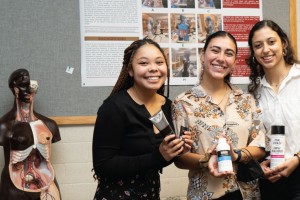Centenary students create new anatomical models to diversify biology lab

SHREVEPORT, LA – This spring, three Centenary students collaborated with a faculty member in the College’s biology department to transform existing anatomical models and diversify the biology lab experience. The students, Yosi Bouslog, Jazmine Carroll, and April Jones, presented an overview of their project and its implications at Centenary’s annual research conference in April.
Anatomical models are an important tool used in biology lab courses, but the vast majority of commercially-available models depict bodies that are young, lean, white, and male. According to Dr. Anna Leal, assistant professor of biology and kinesiology, there are currently only two non-white anatomical models available on the market. The Centenary students were inspired to alter some of the College’s existing anatomical models by a Harvard University initiative, Addressing Bias in Medical Education through Inclusive Anatomical Representation.
“We recognized that there is a lack of diversity, not only in the medical field, but in the education necessary to train future physicians and healthcare workers,” explained Carroll. “Almost all anatomical models display slim, white bodies, even though our population consists of people of different shapes, sizes, and cultures. We saw these anatomical models as an opportunity to represent those who are rarely represented.”
The students worked on the models for a total of five weeks, sanding and priming the existing surfaces and then applying multiple layers of oil paint to create a realistic appearance. Finding the right texture and shades of paint proved to be a process of trial and error, and the students view the painting project as just the first step in a larger effort.
“As women of color, we’ve always been aware of ways that our school and other schools could improve in the areas of diversity and representation,” said Carroll. “There is much that needs to be done. This project was just a small step in the effort to make biology and STEM education more inclusive. Our project is not complete, either. We want to add details and 3D print organs to represent people of different ages and sizes.”
The students are hopeful that their project has illuminated concrete steps that may help diversify other educational spaces on the Centenary campus and beyond. Healthcare and other professionals will encounter a diverse group of people throughout their careers, so providing representation of diverse individuals and experiences is a key part of comprehensive training.
“Having lab spaces that spotlight diverse bodies will better prepare our students to serve all patients in the medical and allied health fields, hopefully contributing to health equity,” said Leal. “These models could also be important for prospective students and parents, who will see that we prioritize inclusion and representation in our lab spaces.”
